Guy Drieghe Franšois Palmyre
Some highlights:
- La Chute de la Maison Usher ~ Marc Ghens ~ 1981/'92 || Film score
- Het is Theater Zoals te Verwachten en te Voorzien Was ~ Jan Fabre ~ 1982/2012 || Theatre music
- Sexual Healing ~ Marvin Gaye ~ 1982 || Private teacher & synth programming
- Kubiek ~ Piet Leterme ~ 1984 || Score for Animated Short
- Same Player... ~ Stef Viaene ~ 1984 || Animated Short music (w/ Win van den Abbeele)
- Events as Restricted Areas || Art gallery Live performance, with Bavo Geryl (bass)
- Polychroma/Semicroma || Live music for chamber orchestra, conducted by Luc Brewaeys
- Diphthongs/Phone´n || Recordings with Rolande Van der Paal (soprano)
- Untitled Art ~ Joris Ghekiere ~ 1985 || Live Art performance
- Frames ~ Stef Viaene ~ 1986 || Shadow Play Theatre music
- Live performance with analog electronics in "Het Bos", Antwerp ~ 2014
- Live set on 3 Buchla Music Easels for "All Connected #8" at the AB, Brussels ~ 2015
- Curator of (and performer in) the Andre Stordeur Tribute festival for Antenna ~ 2020
- ... and many more performances and live concerts.
Milestones:
- 1969 ~ Won first prize in the Agfa Gevaert National Photography Competition, as an eleven year old kid between mainly adults.
- 1976 ~ First [and only] concert with his band "Excess", with MarcE (guitar) & 'Dicky' (percussion), leaving the young audience near deaf & blind (pyrotechnics FTW!)...
- 1980 ~ Called in by Servitec, a measurement equipment company, to streamline & demonstrate their newly acquired Roland Synthesizers distribution deal. Thusly, the very first TR808, TB303, Jupiter 8, MicroComposers et al in the Benelux always went first through my hands... After thanking him for his dedication & knowledge, this then later became Roland Benelux.
- 1981 ~ Released a seminal cosmic music album "Enigmas" with Walter C. Rothe (as Pillion). The master tapes of the follow-up album "Fear" were destroyed in a fire, and thusly never released.
- 1981 ~ Worked with Marvin Gaye (as his private synth teacher) on his album "Midnight Love", at his home in Ostend, BE. Handpicked a demo tape of "Sexual Healing", and programmed all the drums [TR808], bass [TB303] & synths for that. Due to a conflict with Marvin's Belgian manager, I got never credited for my work.
- 1981-82 ~ Designed and co-developed the AEMIT modular synth, with ir. Wim Verheyen. Just before a commercial release, the project was abandoned by mr. Verheyen.
- 1985-86 ~ Worked as a salesman for MicroConnection Distribution, a soft- and computer hardware shop.
- 1987 ~ Founded "Atacom", a computer shop & distributor in Antwerp, specialised in hi-end prepress & DTP systems. Quickly became the 2nd largest Atari distributor in the Benelux.
- 1988 ~ Founded "Quick Brown Fox", a software development company. Developed graphical software to produce robotfoto's for international police forces. After failure to compete with IBM, we converted the application into a popular game "FunFace".
- 1990 ~ Changed Atacom into "Ad Work", an advertising agency & DTP outlet specialised in highly technical documents for an international clientele. Was beta-tester for Agfa Gevaert & Adobe's first version of Photoshop.
- 1992-93 ~ Worked as a user-interface designer for 3K-Computerbild (Duesseldorf), an affiliate of Steve Jobs' NeXT Computer. Co-designed "Retouche", a Photoshop killer. Which, for obvious reasons, never took off.
- 1995-96 ~ 3D-Animator for Pixit, Brussels. Did the intro-reels for "Het Nieuws" (national TV news ), "Blokken" (TV game show), Belgacom, etc...
- 1997-98 ~ Webdesigner for NetVision, Leuven. Designed the very first Belgian banking site and other large-scale sites, and the first Flash-driven sites for TV channels.
- 1999 ~ Became a member of the elusive "Hell.com" domain, an independent [and hidden] entity for "Web Artists", a.k.a. clever ways to crash Netscape.
- 2002-2020 ~ Graphic designer, database developer and mostly photographer for the internationally renowned "Ann Demeulemeester" fashion label.
Throughout:
Workshops & studies with Andre Stordeur, Morton Subotnick, John Cage, Eric Feremans, John Beyls. I have also conducted synthesis & musique-concrete workshops myself, for which I wrote several booklets and courses about analogue synthesis techniques.
Photography, almost always present. Had my first digital camera in 1994 (Apple QuickTake 100), and wrote several online courses with tips & tricks for digital photography.
I am available for performances in select small venues, art-galleries or similar.
Also open to collaborations with other like-minded artists, preferably classically-schooled traditional or ethnic acoustic instrumentalists.
Get in touch.
Music
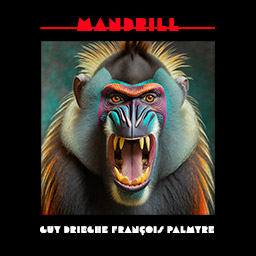
MANDRILL
New compositions for hybrid electronics, to be released Summer 2024.
Will be performed live as well (in quadrophonic audio).
[work in progress]
BISMUTH ~ selected ambient hybrids
BISMUTH (selected ambient hybrids) is a Limited Edition [56] CD-box; composed, performed, recorded & mastered by Guy Drieghe in 2014. It was sold only as a private release.
All tracks available on Soundcloud.
SL1-PL1
For analog electronics, hybrid effects, and a Tibetan horn (2014).
Recording of a live performance in "Het Bos", 19 Sept '14, Antwerp.
QUARTERMAIN
For grand piano, prepared piano, electronics, and digital processors (ca. 1981).
Restored from cassette tape, digitally enhanced during re-mastering.
PHONE¤N
For coloratura soprano (Rolande Van Der Paal) and electronics (1983).
Remastered from cassette tape; noise & hum removed, but mostly untouched.
DIPHTHONGS
Avant-garde electronic music composition, appr. 1985.
Remastered from cassette tape (some noise is audible).
Edited for length, dynamics & fades...
Performed on Synthi AKS, ARP 2600, the Aemit modular, and other synths.
PER ENDULA ~ Act I (Circles of Monarchs)
Avant-garde electronic music composition, 2012.
initial studies for a longer piece... [though never completed].
Performed on the STCFTHOTS analogue modular system.
COCHLEA
Avant-garde electronic music composition, 1985.
Performed on the Aemit modular synthesizer, recorded digitally on PCM tape.
Set the Controls for the Heart of the Sun
Analog Modular Music Synthesizer System
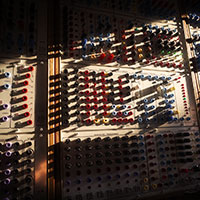 From early 2009 until 2011 I had build my own analog modular synthesizer system, based on 30-yo original Serge technology, Buchla clones, and some other modules I designed myself.
From early 2009 until 2011 I had build my own analog modular synthesizer system, based on 30-yo original Serge technology, Buchla clones, and some other modules I designed myself.
It shares the look & feel of typical Serge/STS systems, and is housed in four semi-portable cabinets containing four 19" panels each. The stcfthots system contains about 150 separate function blocks. It has 9 oscillators, 7 filters (various kinds), 4 resonant lopass gates, 4 sequencers/programmers, and 20 VC slope generators. Amongst the more esoteric modules are a frequency shifter, extended source of uncertainty, modulo processor, harmony generator, and a 10-stage VC vactrol phaser. Randomness is generated by a choice of 11 dedicated modules. Tactile interfaces include a ribbon controller, pressure-sensitive resistive sensors, joysticks, and a contact mic with a velocity-to-midi interface. The system talks to the outside world via two midi-to-CV/Gate interfaces, and communicates with my DAW via a DC-coupled audio interface. I often use a microphone with an envelope follower and Schmitt trigger to control various parameters of the synth; a pitch follower is used as well.
In 2022, after yet another house-move, I dismantled and took apart the whole system and used some of its innards to build a few smaller systems.
Buchla Easel Interfaces
Model 644 Expander Box
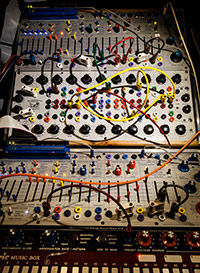 In 2014 I designed & developed a so-called breakout expander box for my two Buchla (BEMI) Easels. The Twin-Easel Model 644 Interface sits between a fully-fledged Easel (Stored Program Sound Source Model 208 + Touch Activated Voltage Source Model 218) and another Model 208 (sans keyboard). It allows communication and patchboard interchange between the two machines through a newly developed custom Program Card, which sends and receives analog data over two 40-pin flat ribbon connectors. The Model 644 Interface doubles all of the standard CV inputs on each Easel (Pitch, Timbre, Period, LPG Levels, etc), and adds extra CV control over the Envelope's Attack, Sustain & Decay parameters, as well as CV control over the Sequencer's number of steps. The 208's Sequencer has pulse outputs for each step, and Envelope, Pulser & Keyboard I/O pulses are available as well.
In 2014 I designed & developed a so-called breakout expander box for my two Buchla (BEMI) Easels. The Twin-Easel Model 644 Interface sits between a fully-fledged Easel (Stored Program Sound Source Model 208 + Touch Activated Voltage Source Model 218) and another Model 208 (sans keyboard). It allows communication and patchboard interchange between the two machines through a newly developed custom Program Card, which sends and receives analog data over two 40-pin flat ribbon connectors. The Model 644 Interface doubles all of the standard CV inputs on each Easel (Pitch, Timbre, Period, LPG Levels, etc), and adds extra CV control over the Envelope's Attack, Sustain & Decay parameters, as well as CV control over the Sequencer's number of steps. The 208's Sequencer has pulse outputs for each step, and Envelope, Pulser & Keyboard I/O pulses are available as well.
Additionally - and most importantly - the Model 644 Interface turns the Easels into stereo synths, with voltage-controlled panning (through vactrol circuits), independent for each Easel. Two built-in comparators can generate Easel pulses from any source, allowing for full timing synchronicity between the two Easels, and/or any other external machine.
The Model 644 front panel is laid out so that most CV/Pulse outputs from one Easel are only a shorting-bar away from the CV/Pulse inputs from the other Easel (cross-patching). The custom Program Card still accepts regular Buchla Program Cards.
Model 416 Meta Expander
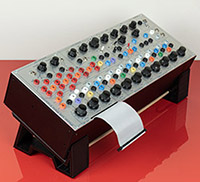 As a follow-up to the personal Model 644, I designed a new expander for just one Easel. The first version (aptly named "V1") was finished in early 2018 and used the same design philosophy as the Model 644, but with extra functionality added. The bottom row of knobs and jacks once again doubled up the available patchpoints of the 208, whilst adding extra CV control of the Envelope, the number of Sequencer steps, and almost all switches of the 208. The top half of the unit featured a Noise section, two Comparators, a Buchlafied version of Serge's Slope Generator, and a 3-channel Processor (aka a DC-coupled mixer with bipolar controls). Similar to the Model 644, the Model 416 also offered access to the Easel's pulse in- and outputs. Communication with the Easel went via a 52-pin ribbon cable - coming out of the left side of the expander - and a custom Program Card interface. That sideway interfacing wasn't my best decision...
As a follow-up to the personal Model 644, I designed a new expander for just one Easel. The first version (aptly named "V1") was finished in early 2018 and used the same design philosophy as the Model 644, but with extra functionality added. The bottom row of knobs and jacks once again doubled up the available patchpoints of the 208, whilst adding extra CV control of the Envelope, the number of Sequencer steps, and almost all switches of the 208. The top half of the unit featured a Noise section, two Comparators, a Buchlafied version of Serge's Slope Generator, and a 3-channel Processor (aka a DC-coupled mixer with bipolar controls). Similar to the Model 644, the Model 416 also offered access to the Easel's pulse in- and outputs. Communication with the Easel went via a 52-pin ribbon cable - coming out of the left side of the expander - and a custom Program Card interface. That sideway interfacing wasn't my best decision...
So, in 2020, I followed up with a Version 2 (pictured at left), this time featuring a much better 208-interface coming out from the bottom-left of the Model 416 frontpanel. A lot more practical, whilst keeping the ribbon as short as possible to reduce possible signal interference. Most extra functionality was kept the same as in V1, but adding a voltage-controlled S/H, a simple AD Generator, a Manual Gate, a buffered OR mixer, and a more performant 3-ch Mixer.
Early 2022 I started working on a Version 3, re-designing from the ground up all function blocks, and adding a few more thingies. One of the more ambitious goals was to completely redesign Serge's USG, abandoning the original (but already Buchlafied) schematics for a much more modern design. I did succeed in doing so, but some other parts of V2 were riddled with mysterious and apparently-insolvable bugs, leaving me with no choice but to bury the whole project early 2023.
AEMIT
The original one
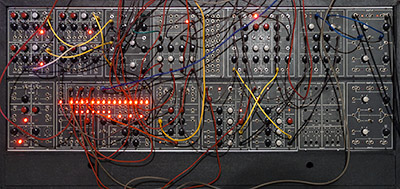 Having used quite a few modular, semi-modular and regular synths since the mid-seventies, I was never really happy with what they offered... there was always at least one particular function missing I desperately needed to be able to create what I had in mind. All commercially available systems were compromised in one way or the other (at that time no Buchla nor Serge systems were available or affordable in my part of the world). What !? No voltage control over the Envelope's slopes ? No voltage-controlled panning ? No decent clocking system ?
Having used quite a few modular, semi-modular and regular synths since the mid-seventies, I was never really happy with what they offered... there was always at least one particular function missing I desperately needed to be able to create what I had in mind. All commercially available systems were compromised in one way or the other (at that time no Buchla nor Serge systems were available or affordable in my part of the world). What !? No voltage control over the Envelope's slopes ? No voltage-controlled panning ? No decent clocking system ?
By the end of that decade, a kinda school for electronic music synthesizers somehow emerged in Antwerp, which also offered DIY kits to build your own modular synth. Apart from Eric Feremans, the founder of ELK-Muziek, there were also teachers in both synthesis and electronics departments. There I met Wim Verheyen, whom was studying for electronics engineer at that time. Together we designed and developed the Aemit Modular System, which we finished & presented in 1982. Mostly based on CEM chips, it consisted of four wide-range ultrastable VCO's, a 4-ch VC Mixer, a dual state variable VCF, four VCA's, two VC ADSR's, a dual Noise-S/H module, a dual External Signal Processor (with a tape interface!), four VC Panner/XFaders, and last but not least a superb VC Master Clock. That Clock had 30 (!) Trigger & Gate outputs of standard note-value and triplet divisions. An 8-step gate sequencer plus a 4-step CV sequencer, some Boolean logic, external interfacing, and most importantly, full voltage control over all of its transport functionality. Forty years and a lot of computing power later, I've never seen any new/other synthesizer module come even close to what the Aemit Master Clock was capable of. An incredible system, the first Aemit modular, mainly because of its consistence in behaviour, its precision, and its logical user interface... It was still fully working until 2020.
The new one
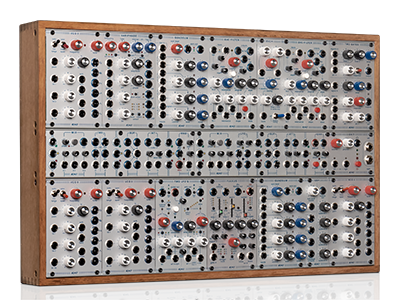
Thirty-five years later, early 2017, Wim Verheyen and I met up again and agreed to give it another shot, this time hopping on the bandwagon of the booming Eurorack world of modular synthesis. My nephew Didah Drieghe joined us early on as we set out the guidelines and goals of what was going to be an evolutionary (and perhaps also a revolutionary) step forwards in modular synthesis. Our main adagio: "Voltage Controlled Everything"...
Beginning within familiar territory, we first redesigned the old Aemit VCO, adapted it to Eurorack standards (ouch), and added a bit more functionality. Old school and not really revolutionary, but still a solid & reliable workhorse oscillator/LFO. Immediately after that [first test], we began working on our own microprocessor board (STM32-based), which was to become the heart of our planned digital modules. Not an easy task, mind you, given our inexperience in digital PCB layout... but we somehow managed, even after adding hi-end ADC's & DAC's. A logical follow-up to the digital Mother Board was to be the ultimate VCO, the VariPhase. A beast of an oscillator, with voltage control over its amplitude and phase (with separate outputs and selectable waveforms), lin FM (through zero) and expo FM, sync, and a nifty method of shifting and spreading (detuning) the individual phases, all whilst retaining precise control over its tuning. I've never encountered another [hardware] oscillator offering such endless possibilities, and sounding this good. Other modules followed quickly : Quadsum (4-ch VC Mixer/quad VCA), Two Gates (dual VCA with VC-Response & 4quadrant functionality), the incredible EVC State Variable Filter (full voltage control over Resonance, State, and 6dB-to-24dB Slopes), the immensely powerful Two LFOs (too many features to sum up here), Fluxus (5-stage Envelope Generator with voltage control over each timing & level parameter), and finally a whole bunch of Utility Modules (RND, Noise, AD, etc) in our proposed new 1.5U format (the middle row in the picture).
In a distribution deal we made with Berlin-based Schneider's Laden, we were given the incredible chance of presenting our system at Superbooth 2019. The response was overwhelming, with perhaps the proudest moment of my synth-design career happening when Wowa Cwejman (✝ 2021)- one of the greatest synthesizer designers - approached me and told me "your system is, to me, the only revolution here worth checking out". Wowsa, so to speak.
A bit later, on my birthday in June, we were going to officially announce the availability of our system and present it to the world at an event in Antwerp, when I unexpectedly received an email from mr. Verheyen, telling me that he'd withdrawn and no longer wanted to "have anything to do with synthesizers", effective immediately. This was the second time he'd done this to me, thereby ending a long friendship, and my possible career in synthesizer design, a lifelong dream of mine.
2023
I'm done tinkering with circuit schematics, laying out PCB's, soldering, and generally wondering why things don't work as I expect them to do... (stop wondering, Guy, you're not an engineer). So I've decided to abandon the impossible, and re-boot my career as a musician/composer -- what I was supposed to be in the first place. Amen.

 From early 2009 until 2011 I had build my own analog modular synthesizer system, based on 30-yo original Serge technology, Buchla clones, and some other modules I designed myself.
From early 2009 until 2011 I had build my own analog modular synthesizer system, based on 30-yo original Serge technology, Buchla clones, and some other modules I designed myself. In 2014 I designed & developed a so-called breakout expander box for my two Buchla (BEMI) Easels. The Twin-Easel Model 644 Interface sits between a fully-fledged Easel (Stored Program Sound Source Model 208 + Touch Activated Voltage Source Model 218) and another Model 208 (sans keyboard). It allows communication and patchboard interchange between the two machines through a newly developed custom Program Card, which sends and receives analog data over two 40-pin flat ribbon connectors. The Model 644 Interface doubles all of the standard CV inputs on each Easel (Pitch, Timbre, Period, LPG Levels, etc), and adds extra CV control over the Envelope's Attack, Sustain & Decay parameters, as well as CV control over the Sequencer's number of steps. The 208's Sequencer has pulse outputs for each step, and Envelope, Pulser & Keyboard I/O pulses are available as well.
In 2014 I designed & developed a so-called breakout expander box for my two Buchla (BEMI) Easels. The Twin-Easel Model 644 Interface sits between a fully-fledged Easel (Stored Program Sound Source Model 208 + Touch Activated Voltage Source Model 218) and another Model 208 (sans keyboard). It allows communication and patchboard interchange between the two machines through a newly developed custom Program Card, which sends and receives analog data over two 40-pin flat ribbon connectors. The Model 644 Interface doubles all of the standard CV inputs on each Easel (Pitch, Timbre, Period, LPG Levels, etc), and adds extra CV control over the Envelope's Attack, Sustain & Decay parameters, as well as CV control over the Sequencer's number of steps. The 208's Sequencer has pulse outputs for each step, and Envelope, Pulser & Keyboard I/O pulses are available as well. As a follow-up to the personal Model 644, I designed a new expander for just one Easel. The first version (aptly named "V1") was finished in early 2018 and used the same design philosophy as the Model 644, but with extra functionality added. The bottom row of knobs and jacks once again doubled up the available patchpoints of the 208, whilst adding extra CV control of the Envelope, the number of Sequencer steps, and almost all switches of the 208. The top half of the unit featured a Noise section, two Comparators, a Buchlafied version of Serge's Slope Generator, and a 3-channel Processor (aka a DC-coupled mixer with bipolar controls). Similar to the Model 644, the Model 416 also offered access to the Easel's pulse in- and outputs. Communication with the Easel went via a 52-pin ribbon cable - coming out of the left side of the expander - and a custom Program Card interface. That sideway interfacing wasn't my best decision...
As a follow-up to the personal Model 644, I designed a new expander for just one Easel. The first version (aptly named "V1") was finished in early 2018 and used the same design philosophy as the Model 644, but with extra functionality added. The bottom row of knobs and jacks once again doubled up the available patchpoints of the 208, whilst adding extra CV control of the Envelope, the number of Sequencer steps, and almost all switches of the 208. The top half of the unit featured a Noise section, two Comparators, a Buchlafied version of Serge's Slope Generator, and a 3-channel Processor (aka a DC-coupled mixer with bipolar controls). Similar to the Model 644, the Model 416 also offered access to the Easel's pulse in- and outputs. Communication with the Easel went via a 52-pin ribbon cable - coming out of the left side of the expander - and a custom Program Card interface. That sideway interfacing wasn't my best decision... Having used quite a few modular, semi-modular and regular synths since the mid-seventies, I was never really happy with what they offered... there was always at least one particular function missing I desperately needed to be able to create what I had in mind. All commercially available systems were compromised in one way or the other (at that time no Buchla nor Serge systems were available or affordable in my part of the world). What !? No voltage control over the Envelope's slopes ? No voltage-controlled panning ? No decent clocking system ?
Having used quite a few modular, semi-modular and regular synths since the mid-seventies, I was never really happy with what they offered... there was always at least one particular function missing I desperately needed to be able to create what I had in mind. All commercially available systems were compromised in one way or the other (at that time no Buchla nor Serge systems were available or affordable in my part of the world). What !? No voltage control over the Envelope's slopes ? No voltage-controlled panning ? No decent clocking system ?